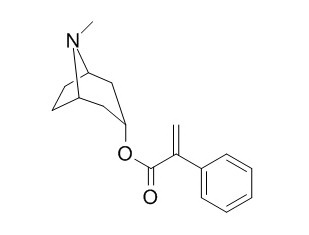Apoatropine
Reference standards.
Inquire / Order:
manager@chemfaces.com
Technical Inquiries:
service@chemfaces.com
Tel:
+86-27-84237783
Fax:
+86-27-84254680
Address:
1 Building, No. 83, CheCheng Rd., Wuhan Economic and Technological Development Zone, Wuhan, Hubei 430056, PRC
Providing storage is as stated on the product vial and the vial is kept tightly sealed, the product can be stored for up to
24 months(2-8C).
Wherever possible, you should prepare and use solutions on the same day. However, if you need to make up stock solutions in advance, we recommend that you store the solution as aliquots in tightly sealed vials at -20C. Generally, these will be useable for up to two weeks. Before use, and prior to opening the vial we recommend that you allow your product to equilibrate to room temperature for at least 1 hour.
Need more advice on solubility, usage and handling? Please email to: service@chemfaces.com
The packaging of the product may have turned upside down during transportation, resulting in the natural compounds adhering to the neck or cap of the vial. take the vial out of its packaging and gently shake to let the compounds fall to the bottom of the vial. for liquid products, centrifuge at 200-500 RPM to gather the liquid at the bottom of the vial. try to avoid loss or contamination during handling.
Eur J Pharmacol.2021, 906:174220.
Front Pharmacol.2017, 8:205
Molecules.2018, 23(7):E1817
J Chromatogr B Analyt Technol Biomed Life Sci.2020, 1149:122123.
Phytomedicine.2022, 99:154025.
Synthetic and Systems Biotechnology2023, j.synbio.
Phytomedicine.2021, 93:153789.
Anal Bioanal Chem. 2016, 408(15)
SSRN2024, 4937625.
Pharmaceuticals (Basel).2024, 17(3):352.
Related and Featured Products
J Chromatogr A. 2005 Oct 14;1091(1-2):32-9.
Simultaneous analysis of hyoscyamine, scopolamine, 6beta-hydroxyhyoscyamine and apoatropine in Solanaceous hairy roots by reversed-phase high-performance liquid chromatography.[Pubmed:
16395790]
METHODS AND RESULTS:
A new high-performance liquid chromatographic method is described for tropane alkaloid analysis in genetically transformed root cultures of Datura innoxia Mill. and Atropa belladonna L. Sample preparation, tropane alkaloid extraction with chloroform-methanol-concentrated ammonia 15:5:1 (v/v/v), was followed by solid-phase extraction on Supelclean LC-18 cartridges. Optimized conditions and careful pH control resulted in high recovery and reproducibility. Simultaneous determination of Apoatropine, 6beta-hydroxyhyoscyamine, hyoscyamine and scopolamine was performed by HPLC on C18 (2) reversed-phase column. The application of Luna new-generation silica-based stationary phase resulted in excellent peak shapes using an ion-pair reagent and triethanolamine free mobile phase and allowed to exploit the full power of pH-dependent selectivity.
CONCLUSIONS:
Simplicity and improved selectivity make this method a preferred alternative of published ion-pair chromatographic methods. Validation studies proved that the global method has good repeatability and satisfactory recovery. Absolute limits of detection were 0.6, 0.6, and 0.8 ng for hyoscyamine, 6beta-hydroxyhyoscyamine, and scopolamine respectively.



